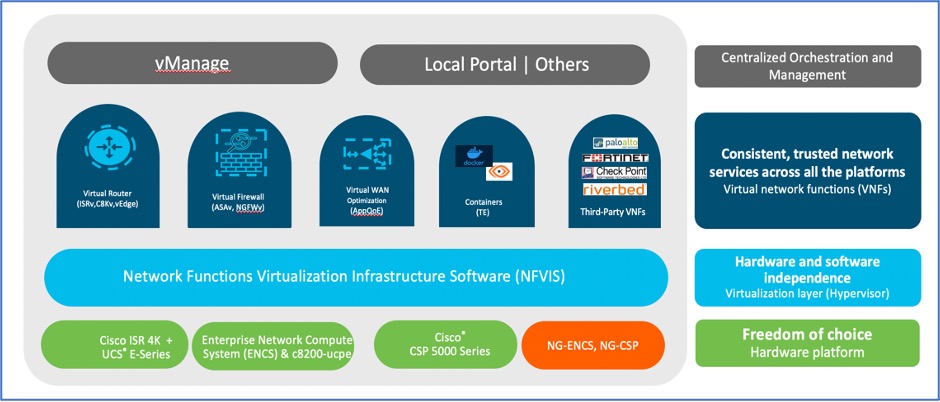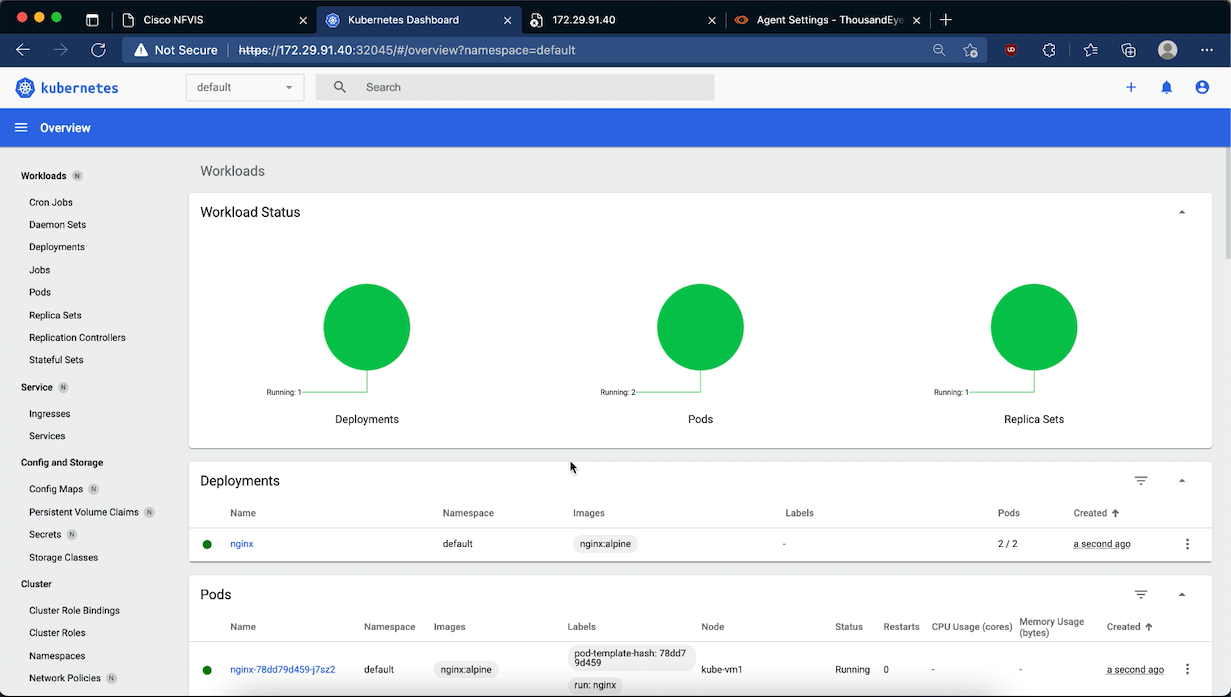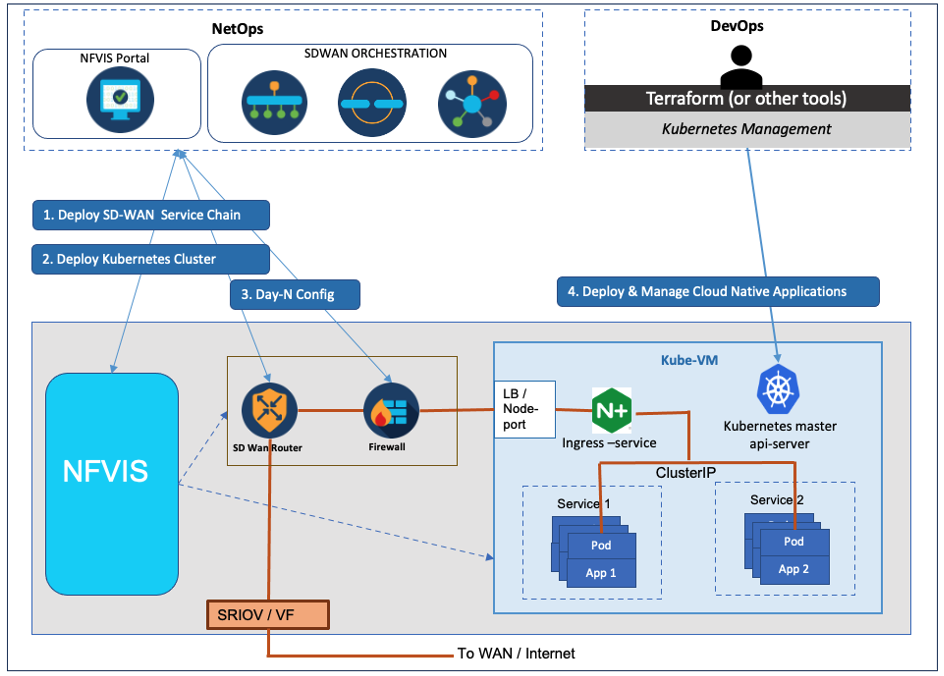To support edge use cases such as distributed IoT ecosystems and data-intensive applications, IT needs to deploy processing closer to where data is generated instead of backhauling data to a cloud or to the campus data center. A hybrid workforce and cloud-native applications are also pushing applications from centralized data centers to the edges of the enterprise. These new generations of application workloads are being distributed across containers and across multiple clouds.
Network Functions Virtualization (NFV) focuses on decoupling individual services—such as Routing, Security, and WAN Acceleration—from the underlying hardware platform. Enabling these Network Functions to run inside virtual machines increases deployment flexibility in the network. NFV enables automation and rapid service deployment of networking functions through service-chaining, providing significant reductions in network OpEx. The capabilities described in this post extend service-chaining of Virtual Network Functions in Cisco Enterprise Network Function Virtualization Infrastructure (NFVIS) to cloud-native applications and containers.
Cisco NFVIS provides software interfaces through built-in Local Portal, Cisco vManage, REST, Netconf APIs, and CLIs. You can learn more about NFVIS at the following resources:
- Virtual Network Functions lifecycle management
- Secure Tunnel and Sharing of IP with VNFs
- Route-Distribution through BGP NFVIS system enables learning routes announced from the remote BGP neighbor and applying the routes to the NFVIS system; as well as announcing or withdrawing NFVIS local routes from the remote BGP neighbor.
- Security is embedded from installation through all software layers such as credential management, integrity and tamper protection, session management, and secure device access.
- Clustering combines nodes into a single cluster definition.
- Third-party VNFs are supported through the Cisco VNF Certification Program.

Virtualizing network functions sets the stage for managing container-based applications using Kubernetes (k8s). Cisco NFVIS enables service chaining for cloud-native containerized applications for edge-compute deployments to provide secure communication from data center to cloud to edge.
Integrate Cloud-Native Applications with Cisco Kubernetes
Cisco’s goal is to make it easy for both NetOps and DevOps to work together using the same dashboard to perform the entire process of registering, deploying, updating, monitoring VMs, and provision service chains with the easy-to-use Cisco Enterprise NFVIS Portal or Cisco vManage for SD-WAN. NetOps persona can perform each step of the VNF lifecycle management to deploy VNF-based service chains.
Cisco NFVIS now includes Cisco Kubernetes to provide centralized orchestration and management of containers. Cisco Kubernetes is available to download through Cisco’s NFVIS Software site. The current release supports the deployment of Cisco Kubernetes through NFVIS Local Portal and NFVIS APIs using existing NFVIS Lifecycle Management Workflows.
Cisco Kubernetes has a built-in Kubernetes Dashboard, enabling NetOps and DevOps Admins to use standard Kubernetes workflows to deploy and manage networking and application VMs. NetOps Admins acquire access tokens in NFVIS via the built-in GUI Local Portal or NFVIS CLI to access a Kubernetes Dashboard running inside Cisco Kubernetes. NetOps personas can execute their role in establishing VNFs and then hand off administration tokens to DevOps personas to access the Kubernetes Dashboard within Cisco Kubernetes. DevOps uses the dashboard to instantiate and manage their application containers. VNFs can be service chained with applications inside Cisco Kubernetes via an ingress controller that is deployed as part of a Kubernetes cluster to provide load balancing and ingress controls.

Cisco Kubernetes supports two deployment topologies:
- Single node is enabled in the current NFVIS 4.9.1 release.
- In future releases, multi-node topologies will enable capabilities such as high availability..

Collaborative Tools to Simplify Cloud Native Container Applications
Ops team collaboration is made possible by Cisco Enterprise NFVIS and Cisco Kubernetes to power tomorrow’s applications across clouds and edge use cases. Deploying service-chained VNFs has enabled NetOps to simplify support for distributed offices, devices, and applications. Now Cisco Kubernetes in Cisco Enterprise NFVIS provides DevOps with a familiar set of k8s workflows to deploy containerized applications from on-premises to cloud to edge, taking full advantage of the service-chained VNFs managed by NetOps.
Keep up with the latest in networking news by subscribing to Networking Blogs email list
Get curated content from Networking experts at the Networking Experiences Content Hub
Additional Resources:


CONNECT WITH US